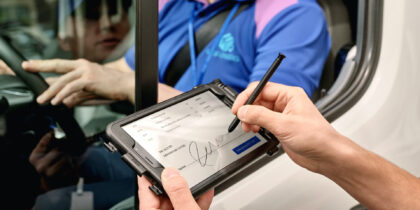Now that the Federal Motor Carrier Safety Administration’s (FMCSA’s) electronic logging device (ELD) mandate is in effect, fleets are beginning to reap some benefits. The FMCSA has said the ELD mandate will save U.S. trucking companies $1.6 billion per year by reducing paperwork costs and improving fuel efficiency. According to The Truckers Report, fuel is the single largest operating cost for trucks — 54 cents per mile, up to $70,000 annually. So, improving fuel efficiency is a high priority for fleet operators.
While it has been estimated that complying with the ELD mandate costs between $199 and $2,200 per truck, plus a monthly service fee of $20 to $60 per truck, according to Trucker.com, fleets can take advantage of bringing these electronic devices into the cab. Fleets are now employing ELDs that plug directly into the vehicle’s engine management computer to record data such as engine speed time of operation, and the onboard GPS tracks parameters such as acceleration and braking.
For small fleets and independent owner/operators, ELD solutions based on Samsung mobile devices offer in-cab telematics that can help drivers and fleets reduce their fuel costs through better driving and improved navigation.

With these devices, fleet managers can ensure the data they are receiving is not only accurate but is easy to use for the drivers and reliable in the field. These capabilities help produce data that can effectively improve operations on a short-term and long-term basis.
Improve Driver Behavior and Fuel Savings
With the information provided by the ELD, fleet managers can track various driving actions such as time spent idling, rapid acceleration and braking hard. Maintenance data such as tire pressure monitoring, engine temperature and oil changes can contribute to improving fuel economy as well.
Managers can work with drivers to improve their skills, which helps to lower maintenance costs, reduce driving risks and improve fuel efficiency. Managers can share driver performance, provide incentives for top performers and identify drivers that might need coaching on effective driving habits for efficient fuel consumption.
How to Modernize Fleet Management
Get your free guide to improving fleet performance and profitability with in-cab mobile technology. Download Now
In a test on seven Class 8 trucks, fleet telematics provider Geotab reported that it was possible to improve fuel efficiency up to nine miles or more per gallon using data from the onboard recorders, compared to the national North American average of 4.51 to 6.37 mpg.
During the study, test drivers used data showing location, fuel, engine load, speed, acceleration and RPM to improve their driving habits. During the three-week, 50,107-mile test, the participating fleets saved $7,193, convserved 2,877 gallons of fuel and achieved 10.1 mpg. With these tangible results, researchers concluded that improving fuel efficiency through collected metrics and driving habits is achievable for fleets.
Create Navigation Efficiencies
ELDs also give fleet managers the ability to monitor vehicles through GPS tracking. Real-time tracking capabilities cut down on the administrative overhead when it comes to dispatching drivers, reducing idle time and empty trips.
Using real-time tracking, managers know when a driver is able to pick up and drop off loads and can be rerouted dynamically for the most efficient routing. This could include routes that have less traffic and lower grades, resulting in less braking and fuel consumption.
GPS integrated with hours-of-service (HOS) tracking lets managers know the driver’s HOS status so they can assign a driver with sufficient time to handle a shipment, reducing unnecessary or excessively long trips.
The GPS tracking provides breadcrumb trails and location history, so fleet managers and drivers can plan out the most efficient routes. After all, the shortest route may not be the best one if it has heavy traffic or is hard to navigate, which could result in increased fuel costs.
For fleets that want to go beyond the basics of compliance with the ELD mandate, fleet telematics provides the perfect foundation to improve fuel efficiency and bring major cost benefits to businesses.
See what connected fleet solutions are available to help you meet company and driver needs.








